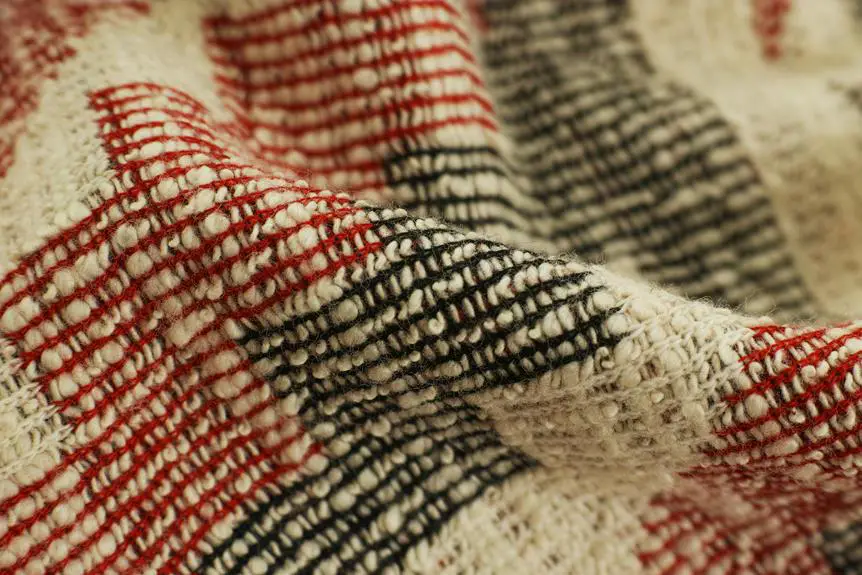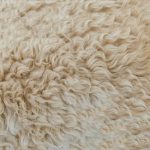When choosing between microfleece and Merino wool, it's essential to consider their unique performance traits and how they align with your activities. You might notice that microfleece offers lightweight insulation and quick-drying capabilities—ideal for intense workouts. On the other hand, Merino wool provides exceptional warmth, breathability, and odor resistance, making it a favorite for colder climates. So, which fabric holds the edge in different environments? Understanding these nuances can significantly impact your comfort and effectiveness during outdoor pursuits.
Table of Contents
Overview of Microfleece
Microfleece is a lightweight, synthetic fabric known for its exceptional warmth and softness, making it a popular choice for outdoor clothing and cozy blankets. You'll appreciate its ability to retain heat without adding bulk, which means you can stay comfortable without feeling weighed down. Its breathable nature helps regulate your temperature, so you won't overheat during high-energy activities.
When it comes to moisture management, microfleece excels by wicking sweat away from your skin, keeping you dry and comfortable. You'll find it particularly useful in varying weather conditions, as it dries quickly if it does get wet. Furthermore, microfleece often comes with a brushed texture that not only feels good against your skin but also enhances insulation properties.
Durability is another strong point; microfleece is resistant to wear and tear, making it a long-lasting investment in your outdoor wardrobe. Plus, it's easy to care for and maintains its qualities after multiple washes. All these factors combine to create a versatile fabric that can adapt to many situations, whether you're hiking in the mountains or lounging at home. When you consider its benefits, it's clear why microfleece is a favorite among outdoor enthusiasts.
Overview of Merino Wool
Merino wool offers a range of natural fiber benefits that make it a popular choice for outdoor enthusiasts.
You'll appreciate its excellent moisture management properties and ability to regulate temperature, keeping you comfortable in various conditions.
Understanding these features can help you choose the right fabric for your adventures.
Natural Fiber Benefits
When it comes to natural fibers, Merino wool stands out for its exceptional warmth, breathability, and moisture-wicking properties.
Unlike synthetic materials, Merino wool is softer against your skin, preventing that itchy sensation often associated with traditional wool.
This comfort level makes it a go-to choice for many outdoor enthusiasts and casual wearers alike.
Merino wool boasts a unique crimp structure that creates insulating pockets of air, keeping you warm without overheating.
Its natural elasticity means it retains its shape well, reducing the risk of sagging or losing fit over time.
Additionally, Merino wool is lightweight, making it easy to pack and wear in a variety of conditions.
One of the standout benefits you'll appreciate is its odor-resistance.
The natural lanolin present in Merino wool helps to neutralize odors, so you can wear it multiple times between washes, which is an invaluable benefit for long trips.
If you're looking for a fabric that marries performance with comfort and versatility, Merino wool checks all the boxes, making it a premier choice for any wardrobe.
In the next section, you'll see how it specifically handles moisture management.
Moisture Management Properties
Understanding how Merino wool manages moisture can further illustrate why it remains a top choice for both outdoor activities and everyday wear.
Merino wool effectively wicks moisture away from your skin, keeping you dry and comfortable. Unlike synthetic fabrics, Merino wool absorbs moisture and releases it into the air, preventing that clammy feeling.
Some key moisture management properties of Merino wool include:
High Absorbency: Merino wool can absorb up to 30% of its weight in moisture without feeling wet, allowing you to stay dry longer.
Breathability: The fiber allows air circulation, enabling sweat to evaporate quickly, which keeps you comfortable during intense activities.
Odor Resistance: Merino wool resists odors, even after prolonged wear, so you can feel fresh thanks to its natural antimicrobial properties.
Temperature Regulation: Merino wool helps regulate body temperature by adapting to changing moisture levels, enhancing your overall experience.
Merino wool's moisture management qualities explain why it is favored by outdoor enthusiasts and everyday users alike.
Temperature Regulation Abilities
Thanks to its unique structure, Merino wool effectively regulates body temperature, keeping you comfortable in various weather conditions. This wool's natural fibers manage heat, providing insulation when it's cold and breathability when it's warm. You'll notice that, unlike synthetic fabrics, Merino can adapt to your body's needs, allowing you to maintain a consistent temperature.
When you wear Merino wool, it traps warmth close to your body, preventing chill without overheating. Its moisture-wicking properties draw sweat away, further enhancing temperature regulation. As sweat evaporates, it cools your skin, allowing for a comfortable experience even during intense activities.
You'll also appreciate that Merino wool resists odors, so you can wear it longer without unpleasant smells. This quality is vital for maintaining comfort in various temperatures and during extended wear. Whether you're hiking in the mountains or lounging at home, Merino wool keeps you feeling just right.
Warmth and Insulation
Microfleece offers lightweight warmth and good insulation, while Merino wool excels in temperature regulation and moisture-wicking properties.
When you're searching for effective insulation, consider these key factors that can influence your choice between the two:
- Weight: Microfleece is lighter and bulkier, making it easy to pack. Merino wool is denser but can be layered for more warmth without adding weight.
- Warmth: Microfleece retains heat well, making it a great option for colder weather. Merino wool provides warmth but also regulates your body temperature to prevent overheating.
- Breathability: Both materials offer breathability, but Merino wool helps maintain a consistent temperature, allowing you to stay comfortable during various activities.
- Drying Time: Microfleece dries quickly, which is ideal if you encounter damp conditions. Merino wool can take longer to dry but has the advantage of staying warm even when slightly wet.
Ultimately, your choice may depend on specific activities and conditions. If you prioritize lightweight insulation, microfleece may be your go-to. However, if you want enhanced temperature control, consider Merino wool.
Moisture Management
When it comes to moisture management, you're going to notice key differences between microfleece and merino wool. Each fabric has distinct absorption rates, drying speeds, and odor resistance properties that can affect your comfort during active pursuits.
Let's explore how these materials perform under pressure so you can make an informed choice.
Fabric Absorption Rates
Many people find that fabric absorption rates play a crucial role in how comfortable they feel during various activities. When you're sweating or in humid conditions, choosing the right material can make a significant difference in your comfort level.
Let's break down the absorption characteristics of microfleece and merino wool.
Microfleece: This synthetic fabric tends to wick moisture away quickly, which helps keep you dry on the surface. However, it doesn't absorb water as effectively, so it can feel damp against the skin after heavy sweating.
Merino Wool: With its natural fibers, merino wool effectively absorbs moisture while still feeling dry. It can hold up to 30% of its weight in moisture without making you feel wet, which is impressive.
Breathability and Odor Resistance: Merino wool's structure allows for excellent airflow, enhancing drying while still managing moisture. Additionally, merino wool naturally resists odors thanks to its ability to absorb sweat, making it a fantastic choice for extended wear.
Drying Speed Comparison
Understanding how fast fabrics dry can make all the difference in your comfort during activities, especially when dealing with moisture management. When you choose between microfleece and Merino wool, their drying speeds play a crucial role in your performance and overall experience.
Microfleece typically dries faster than Merino wool. This quick-drying property makes microfleece an excellent choice for high-intensity activities or situations where you might get wet. If you're hiking in unpredictable weather or engaging in high-energy sports, you'll likely appreciate the rapid moisture evaporation.
On the other hand, Merino wool dries at a slower rate but offers superior moisture-wicking capabilities. It absorbs moisture and moves it away from your skin effectively, but you'll notice it retains some dampness longer than microfleece. In cooler conditions, this can actually be beneficial, as it helps regulate your body temperature.
Ultimately, your decision should factor in the specific activities you plan to engage in. If you prioritize quick drying times, microfleece could be your best bet. If you prefer temperature regulation and moisture management, Merino wool might be the way to go.
Odor Resistance Properties
Microfleece and Merino wool handle odor differently, impacting your overall comfort during extended wear. When you're outdoors or working up a sweat, the materials' unique properties play a key role in odor management.
Let's dive into how they compare:
Microfleece: This synthetic material tends to trap odors more than Merino wool, leading to a smellier experience after prolonged use. It can be cleaned easily, but you may find yourself washing it more often.
Merino Wool: Naturally odor-resistant, Merino wool can absorb moisture without developing unpleasant smells. This makes it an excellent choice for long adventures without frequent washing.
Moisture Wicking: Both fabrics wick moisture away from your skin, but Merino wool does this while keeping its odor resistance intact. Microfleece mightn't be as reliable in keeping you fresh over time.
Longevity: Given its odor resistance, Merino wool often lasts longer between washes, making it a preferred option for multi-day trips or extended wear.
Whether you prioritize comfort or ease of maintenance, understanding their odor resistance will guide your choice between microfleece and Merino wool.
Durability and Care
While both microfleece and merino wool offer comfort, their durability and care requirements sharply differ. Microfleece is known for its resilience; it's a synthetic material that can withstand frequent wear and tear. You can wash it multiple times without worrying about the fabric losing its shape or effectiveness. It dries quickly and typically retains its color even after several washes, making maintenance easy.
In contrast, merino wool, while soft and comfortable, demands a bit more attention. It's naturally durable but can be more susceptible to damage if not cared for properly. You'll want to avoid high heat when washing or drying to prevent shrinking, and gentle cycles are preferred. Although it's less likely to retain odor compared to synthetic fabrics, it can be prone to moth damage.
When it comes to stain removal, microfleece generally handles spills better, while merino wool requires more delicate cleaning techniques. Overall, if you're seeking something easy to care for and long-lasting, microfleece could be your best bet. But if you appreciate the natural properties of merino wool and don't mind a bit of extra care, it can also prove worthwhile.
Best Uses for Each Fabric
Choosing the right fabric for your needs hinges on what activities you plan to engage in, as each material excels in different conditions. Microfleece and Merino wool serve distinct purposes, making it important to match them with your specific requirements.
- Microfleece: Ideal for lightweight insulation during high-energy activities, such as running or hiking. It provides warmth without bulk, making it great for layering.
- Merino Wool: Excellent for colder weather when you need both warmth and moisture-wicking properties. It's perfect for skiing or snowboarding, as it keeps you warm and dry.
- Microfleece: Works well as a cozy fabric for lounging or casual wear. Its soft texture makes it a popular choice for blankets and home wear.
- Merino Wool: Outstanding for travel due to its odor-resistance and ability to regulate body temperature. You can wear it multiple days without washing, making it efficient for longer trips.
Frequently Asked Questions
Is Microfleece More Affordable Than Merino Wool?
Yes, microfleece is generally more affordable than merino wool. It's a budget-friendly option for insulation and comfort. If you're looking to save money while staying warm, microfleece might be the perfect choice for you.
Can Merino Wool Cause Allergic Reactions in Some People?
Yes, merino wool can cause allergic reactions in some people. If you experience itching, rashes, or discomfort while wearing it, you might want to consider alternatives that suit your skin better. Always listen to your body!
How Do Both Fabrics Perform in Windy Conditions?
In windy conditions, you'll find microfleece provides decent warmth and breathability, while merino wool offers excellent insulation, even when damp. Both fabrics help shield you from the wind, though merino's performance often stands out.
Which Fabric Is Better for Layering?
When layering, you'll find microfleece is lightweight and versatile, making it easy to combine with other garments. Merino wool, however, offers superior warmth and breathability, enhancing your comfort in varying conditions. Think about your preferences!
Are There Any Environmental Impacts of Producing Microfleece or Merino Wool?
When considering environmental impacts, microfleece often sheds microplastics, harming marine life. Meanwhile, merino wool production involves land use and water consumption. Both have consequences, so you'll want to weigh them for your needs.
- How Does Ring Spun Cotton Affect Garment Fit and Shape Retention? - August 13, 2024
- What Are the Challenges in Producing Ring Spun Cotton? - August 13, 2024
- Is Ring Spun Cotton Suitable for Plus-Size Clothing? - August 13, 2024







